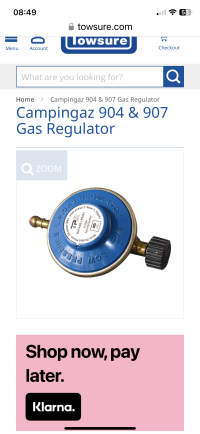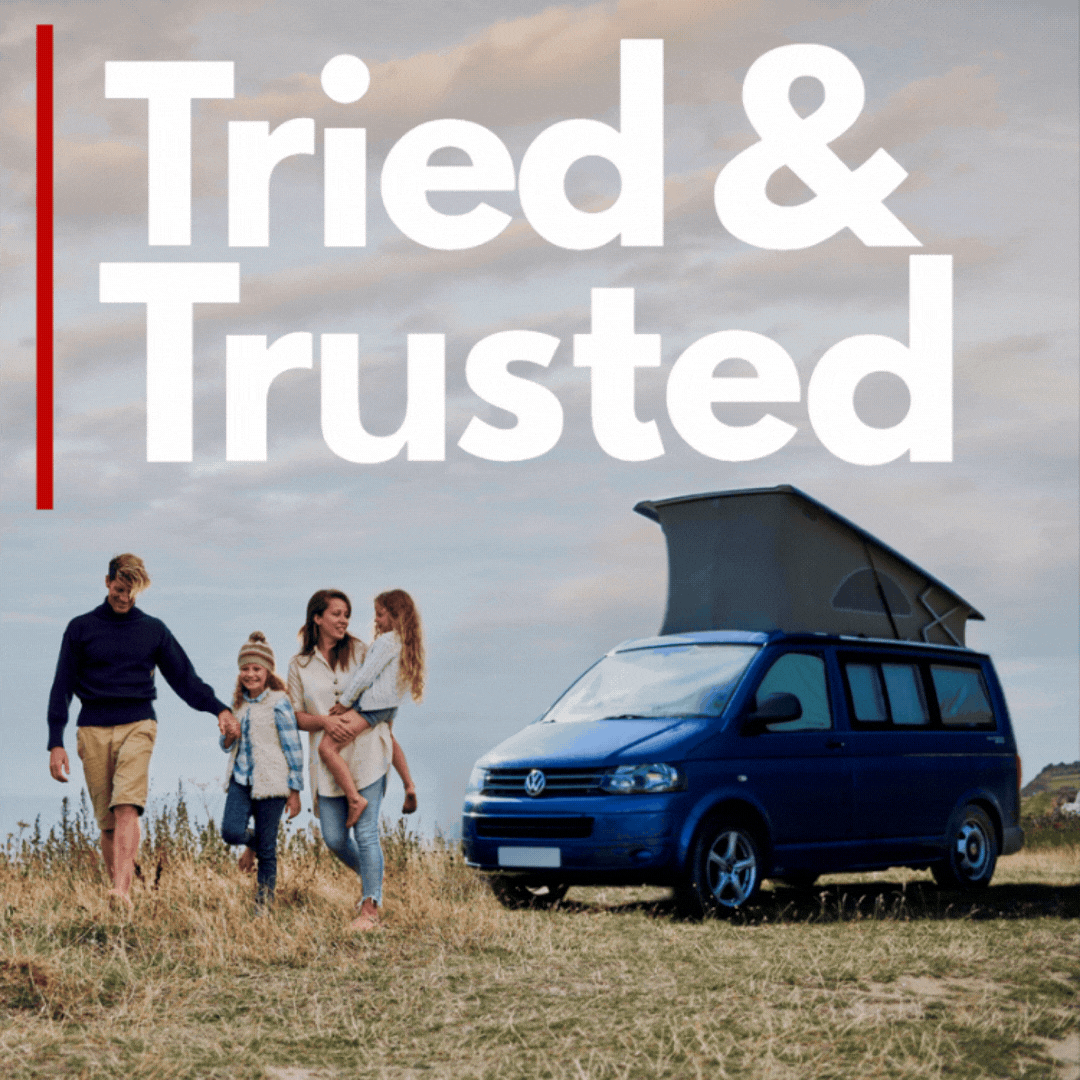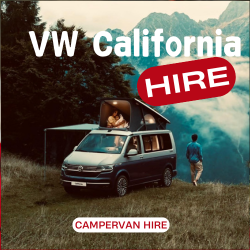- Home
- Forums
- VW California T5 T6 & T6.1 Specific Sections
- VW California T5,T6 & T6.1 Specific Sections
- Gas System
You are using an out of date browser. It may not display this or other websites correctly.
You should upgrade or use an alternative browser.
You should upgrade or use an alternative browser.
Kedaw
Lifetime VIP Member
yes that's the correct one although I would suggest installing the in-line quick connection as shown earlier in this thread. It makes changing the bottle so much easier.My original gas regulator had finally packed up. Would one of these do? Cut the original pipe and secure with a jubilee clip?
View attachment 107507
KGCali
Retired and still young at heart!
Lifetime VIP Member
A good solution, where did you get all the parts from?Just as a follow up, I've now fitted the regulator and in-line quick disconnection and I'm really happy ( a quick and easy job), also changing the bottle will be so much easier and quicker. It also means that if I ever have problems with the regulator I can can change it cheaply, easily and most importantly from any camping shop.
Kedaw
Lifetime VIP Member
Picked up the regulator and hose kit from halfords, but loads of places sell them. The in-line connector was from ebay, not totally necessary but makes changing the gas quicker and easier.A good solution, where did you get all the parts from?
KGCali
Retired and still young at heart!
Lifetime VIP Member
Thanks, did you cut the original hose or get a new hose with fittings to fit the Cali screw fitting?Picked up the regulator and hose kit from halfords, but loads of places sell them. The in-line connector was from ebay, not totally necessary but makes changing the gas quicker and easier.
WelshGas
Retired after 42 yrs and enjoying Life.
Super Poster
Lifetime VIP Member
When I did it I cut the original hose and it wasn't easy, rubber, reinforcement and an inner , what looked like polyurethane lining. It is certainly not plain red rubber.Thanks, did you cut the original hose or get a new hose with fittings to fit the Cali screw fitting?
Kedaw
Lifetime VIP Member
When I did it I cut the original hose and it wasn't easy, rubber, reinforcement and an inner , what looked like polyurethane lining. It is certainly not plain red rubber.
Yes I cut the hose, but I'll replace the rest of the hose in the future.Thanks, did you cut the original hose or get a new hose with fittings to fit the Cali screw fitting?
787driver
Lifetime VIP Member
Finally got around to fitting the regulator. I’ve fitted an inline coupler too for ease of tank removal. However, after finally fitting the pipe to the regulator and one end of the coupler I am struggling to fit the other end of the coupler to the other end of the pipe which is attached to the van. Any suggestions? It’s the original pipe with twin lining
Kedaw
Lifetime VIP Member
Soak the pipe in boiling water for a while and apply a little washing up liquid to the fitting when putting them together. If you push the pipe down onto the fitting on a hard surface this really helps.Finally got around to fitting the regulator. I’ve fitted an inline coupler too for ease of tank removal. However, after finally fitting the pipe to the regulator and one end of the coupler I am struggling to fit the other end of the coupler to the other end of the pipe which is attached to the van. Any suggestions? It’s the original pipe with twin lining
KGCali
Retired and still young at heart!
Lifetime VIP Member
Just been looking at replacing my original Gok regulator with a Campingaz type 794 regulator for the 907 bottle but when I read the instructions on the back it states ...
'This regulator is not for use in caravans and motor caravans'.
Any idea why this is as I know a few of you have already done this?
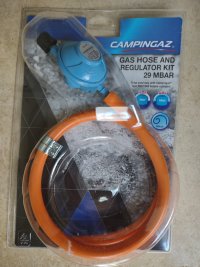
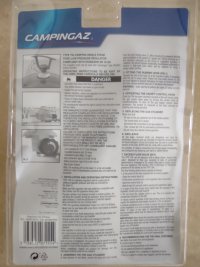
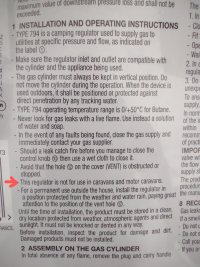
'This regulator is not for use in caravans and motor caravans'.
Any idea why this is as I know a few of you have already done this?



Last edited:
Y
yossarian
Top Poster
Lifetime VIP Member
Here's some reading:Just been looking at replacing my original Gok regulator with a Campingaz type 794 regulator for the 907 bottle but when I read the instructions on the back it states ...
'This regulator is not for use in caravans and motor caravans'.
Any idea why this is as I know a few of you have already done this?
View attachment 108992
View attachment 108993
View attachment 108994

Loose gas connection
Thanks @briwy for the pictures. Fitted it all today. The gas tube has an inner plastic type lining, very difficult to fit tubing, but with judicious use of an electric paint stripper to warm the connectors got the tubing fitted and fuel line clamps. No leaks, even with the Quick Release fitting...
It's quite complex, the GOK regulator is certified to annex d of the standard which applies to motorhomes. At the end of the day you need to decide if some safety features that are quite poorly described are important to you.
My thinking was that I didn't know enough to do it differently to VW.
All of this is complicated by the fact that if you actually want to read the standard you've got to shell out € 500 or so.
Last edited:
WelshGas
Retired after 42 yrs and enjoying Life.
Super Poster
Lifetime VIP Member
These regulators for Campingaz and variations for Calor are widely used in Caravan and Motor Caravans, BUT, they are normally fitted either in external lockers, outside the habitation area or in gas tight lockers with external vent, which is exactly the case with the California.Just been looking at replacing my original Gok regulator with a Campingaz type 794 regulator for the 907 bottle but when I read the instructions on the back it states ...
'This regulator is not for use in caravans and motor caravans'.
Any idea why this is as I know a few of you have already done this?
View attachment 108992
View attachment 108993
View attachment 108994
I have had one fitted for 8 yrs. No problems, no leaks and easy to change cylinders or remove to weigh etc.
Brian’s Dad
I wonder if this would fit in the locker? Maybe not enough head room?
We use the smaller CV cylinders for the BBQ so they could be a a backup.
We use the smaller CV cylinders for the BBQ so they could be a a backup.
andyinluton
Super Poster
VIP Member
- Messages
- 7,732
- Vehicle
- T6.1 Ocean 204 4 motion
These regulators for Campingaz and variations for Calor are widely used in Caravan and Motor Caravans,
No they are not. Since 2004 all regulators on motorhomes & Caravans are supposed to be bulkhead mounted.
I don't know how VW get away with the California installation as the current regulations also state all pipework between the regulator & appliance should be steel or copper, hence the move to bulkhead mounted regulators.
Corradobrit
Probably the same way I got my 80L fuel tank when the dealer said it couldn't be optioned due to the Cali's weight. VW seem to think they are a law unto themselves.I don't know how VW get away with the California installation as the current regulations also state all pipework between the regulator & appliance should be steel or copper, hence the move to bulkhead mounted regulators.
WelshGas
Retired after 42 yrs and enjoying Life.
Super Poster
Lifetime VIP Member
Is that UK or German/EU standards? If that is the case why do Californias leave the factory with German Gas Safety stickers on the tailgate?No they are not. Since 2004 all regulators on motorhomes & Caravans are supposed to be bulkhead mounted.
I don't know how VW get away with the California installation as the current regulations also state all pipework between the regulator & appliance should be steel or copper, hence the move to bulkhead mounted regulators.
andyinluton
Super Poster
VIP Member
- Messages
- 7,732
- Vehicle
- T6.1 Ocean 204 4 motion
Its BSEN1646 which should apply - a British Standard implementation of a European standard.
KGCali
Retired and still young at heart!
Lifetime VIP Member
Here's a useful guide ...
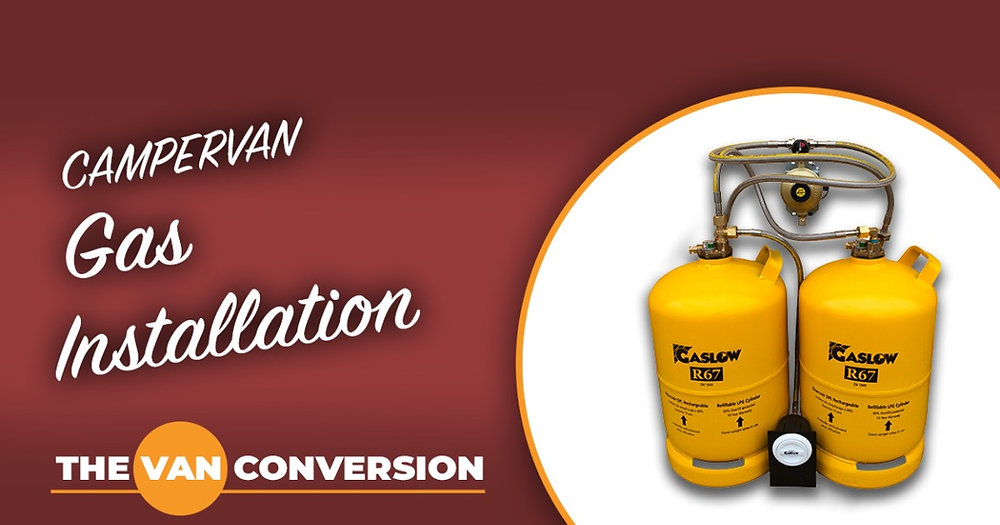
 www.thevanconversion.com
www.thevanconversion.com

The Ultimate Guide to Campervan Gas (LPG) - Gaslow System
This guide teaches you all about campervan gas installations! Including campervan gas bottle, campervan gas locker, and the Gaslow system
 www.thevanconversion.com
www.thevanconversion.com
WelshGas
Retired after 42 yrs and enjoying Life.
Super Poster
Lifetime VIP Member
Well according to that article the VW California fails on a number of points, so is basically illegal in the U.K. and EU and yet it is on sale and has been for 20+ yrs with essentially the same illegal system and every California leaves the factory with a German Gas Safety check/certificate.Here's a useful guide ...

The Ultimate Guide to Campervan Gas (LPG) - Gaslow System
This guide teaches you all about campervan gas installations! Including campervan gas bottle, campervan gas locker, and the Gaslow systemwww.thevanconversion.com
Strange.
andyinluton
Super Poster
VIP Member
- Messages
- 7,732
- Vehicle
- T6.1 Ocean 204 4 motion
Here's a useful guide ...

The Ultimate Guide to Campervan Gas (LPG) - Gaslow System
This guide teaches you all about campervan gas installations! Including campervan gas bottle, campervan gas locker, and the Gaslow systemwww.thevanconversion.com
The blue screw on bottle regulator is single stage & the cali standard is 2 stage.
Extract from the linked document:
Gas Regulator
There are two types of regulators: Single stage regulators and two stage regulators.
A single stage regulator reduces pressure to 30mbars in one step. They’re more compact & cheaper than two stage regulators, but not as accurate. Single stage regulators are normally bottle-mounted - they are for temporary installations and not to be used in campervans.
Instead, it is recommended to use a two stage regulator which reduces the pressure in two steps. They are better at delivering constant pressure as the tank pressure declines and temperature fluctuates.
The blue screw on bottle regulator is single stage & the cali standard is 2 stage.
Wesel
What are the points that you think would make the gas installation of the Cali not legal?Well according to that article the VW California fails on a number of points, so is basically illegal in the U.K. and EU and yet it is on sale and has been for 20+ yrs with essentially the same illegal system and every California leaves the factory with a German Gas Safety check/certificate.
Strange.
WelshGas
Retired after 42 yrs and enjoying Life.
Super Poster
Lifetime VIP Member
Security of gas bottle, 2 straps according to that article, which also quotes the material the pipe work has to be made of and the connections used.What are the points that you think would make the gas installation of the Cali not legal?
VW have their own system which has been in use for many years. I’m not concerned in the slightest.
Y
yossarian
Top Poster
Lifetime VIP Member
Yes I noticed the straps and pipe work. One thing evident in this thread is that the factory fitted rubber pipe is clearly different to standard 10 bar UK lpg pipe.Security of gas bottle, 2 straps according to that article, which also quotes the material the pipe work has to be made of and the connections used.
VW have their own system which has been in use for many years. I’m not concerned in the slightest.
I've experienced extremes of what would be considered normal in many parts of the world: factory VW is certainly safe, probably the various modifications proposed here are pretty safe, certainly much more safe than many things i'm exposed to as a matter of course.
Risk is cumulative. It can never be reduced to zero. We need to be realistic when assessing it.
WelshGas
Retired after 42 yrs and enjoying Life.
Super Poster
Lifetime VIP Member
I’ve not seen many systems where the cylinder is in a sealed , vented gas locker surrounded by a double skinned water tank, and using a “ red rubber “ low pressure gas tube that is reinforced and at least double if not triple skinned with crimped , screw connectors and connected to the Isolation switch via a one piece, stainless steel gas line ( well it looks like stainless steel ).Yes I noticed the straps and pipe work. One thing evident in this thread is that the factory fitted rubber pipe is clearly different to standard 10 bar UK lpg pipe.
I've experienced extremes of what would be considered normal in many parts of the world: factory VW is certainly safe, probably the various modifications proposed here are pretty safe, certainly much more safe than many things i'm exposed to as a matter of course.
Risk is cumulative. It can never be reduced to zero. We need to be realistic when assessing it.
I think I’ll keep with the VWsystem.
Similar threads
- Home
- Forums
- VW California T5 T6 & T6.1 Specific Sections
- VW California T5,T6 & T6.1 Specific Sections
- Gas System

About us
The VW California Club is the worlds largest resource for all owners and enthusiasts of VW California campervans.



